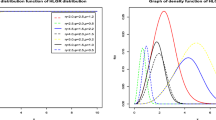Abstract
On-line, real-time collection of measurements remains a key challenge in water quality monitoring and control due to unknown and varying quality of on-line sensor data. Today’s data quality assessment is typically based on a comparison of sensor-based measurements and grab samples of the sampled solution taken next to the on-line analyzer and analyzed in a laboratory. In this work, internal data is used for fault detection and identification of a phosphate analyzer to inspect the measuring process itself. These internal data is shown to be information-rich with respect to the analyzer’s status. Furthermore, this information is captured well by means of a newly developed method for qualitative analysis of time series. This method was developed with global optimality in mind and therefore lends itself to a probabilistic assessment of the qualitative representation of time series.







Similar content being viewed by others
References
Nopens, I., Villez, K., Rieger, L., Vanrolleghem, P.A.: Monitoring the water cycle—state of the art and future needs. IWA Yearbook 2007, 33–36 (2007)
Thomann, M., Rieger, L., Frommhold, S., Siegrist, H., Gujer, W.: An efficient monitoring concept with control charts for on-line sensors. Water Sci. Technol. 46(4–5), 107–116 (2002)
Rosén, C., Röttorp, J., Jeppsson, U.: Multivariate monitoring: challenges and solutions for modern wastewater treatment operation. Water Sci. Technol. 47(2), 171–179 (2003)
Rieger, L., Vanrolleghem, P.A.: monEAU: a platform for water quality monitoring networks. Water Sci. Technol. 57(7), 1079–1086 (2008)
American Public Health Association (APHA), American Water Works Association (AWWA) & Water Environment Federation (WEF): Standard Methods for the Examination of Water & Wastewater: Centennial Edition (Eaton, A.D., L.S., Clesceri, E.W., Rice, A.E., Greenberg, M.A.H. Franson, (Eds.)), Washington D.C., 1368 pp (2005)
Villez, K., Rosén, C., Anctil, F., Duchesne, C., Vanrolleghem, P.A.: Qualitative representation of trends: an alternative approach to process diagnosis and control. Water Sci. Technol. 57(10), 1525–1532 (2008)
Villez, K., Rosén, C., Duchesne, C., Anctil, F., Vanrolleghem, P.A.: Qualitative representation of trends (QRT): extended method for proper inflection point recognition. Comput. Chem. Eng. (2011) (Submitted)
Villez, K., Keser, B., Rieger, L.: Qualitative representation of trends (QRT) as a tool for automated data-driven diagnostics for on-line sensors. In: Proceedings of the 7th IFAC Symposium on Fault Detection, Supervision and Safety of Technical Processes (SafeProcess2009), Barcelona, Spain, 30 June–July 3, 2009, appeared on CD-ROM (2009)
Bakshi, B., Stephanopoulos, G.: Representation of process trends—part III. Multiscale extraction of trends from process data. Comput. Chem. Eng. 18, 267–302 (1994)
Rengaswamy, R., Venkatasubramanian, V.: A syntactic pattern-recognition approach for process monitoring and fault diagnosis. Eng. Appl. Artif. Intell. 8, 35–51 (1995)
Flehmig, F., Watzdorf, R.V., Marquardt, W.: Identification of trends in process measurements using the wavelet transform. Comput. Chem. Eng. 22, S491–S496 (1998)
Akbaryan, F., Bishnoi, P.R.: Smooth representation of trends by a wavelet-based technique. Comput. Chem. Eng. 24, 1913–1943 (2000)
Akbaryan, F., Bishnoi, P.R.: Fault diagnosis of multivariate systems using pattern recognition and multisensor data analysis technique. Comput. Chem. Eng. 25, 1313–1339 (2001)
Dash, S., Maurya, M.R., Venkatasubramanian, V.: A novel interval-halving framework for automated identification of process trends. AIChE J. 50, 149–162 (2004)
Charbonnier, S., Garcia-Beltan, C., Cadet, C., Gentil, S.: Trends extraction and analysis for complex system monitoring and decision support. Eng. Appl. Artif. Intell. 18, 21–36 (2005)
Villez, K., Rengaswamy, R., Venkatasubramanian, V.: Generalized qualitative shape constrained spline fitting. Technometrics (2012) (Submitted)
Parker, R.G., Rardin, R.L.: Discrete Optimization. Academic Press, New York (1998)
Forst, W., Hoffmann, D.: Optimization—Theory and Practice. Springer, New York (2010)
Kuipers, B.: Reasoning with qualitative models. Artif. Intell. 59, 125–132 (1993)
Nesterov, Y.: Squared functional systems and optimization problems. In: Frenk, H., Roos, K., Terlaky, T., Zhang, S. (eds.) High performance optimization, applied optimization, vol. 33, pp. 405–440. Kluwer Academic Publishers, Dordrecht (2000)
Papp, D.: Optimization models for shape-constrained function estimation problems involving nonnegative polynomials and their restrictions. M.Sc. thesis, Rutgers University (2011)
Swan, A.V.: Algorithm AS 16: maximum likelihood estimation from grouped and censored normal data. J. R. Stat. Soc. Ser. C Appl. Stat. 18(1), 110–114 (1969)
Wolynetz, M.S.: Maximum likelihood estimation in a linear model from confined and censored normal data. J. R. Stat. Soc. Ser. C Appl. Stat. 28(2), 195–206 (1979)
Vapnik, V.: The Nature of Statistical Learning Theory, 2nd edn. Springer, New York (1999)
Smola, A.J., Schölkopf, B.: A tutorial on support vector regression. Stat. Comput. 14, 199–222 (2003)
Donoho, D.L., Johnstone, I.M.: Ideal spatial adaptation by wavelet shrinkage. Biometrika 81, 425–455 (1994)
Parsons, S.: Qualitative Methods for Reasoning Under Uncertainty. MIT Press, Cambridge (2001)
Forbus, K.D.: Qualitative process theory. Artif. Intell. 24, 85–168 (1984)
Villez, K., Srinivasan, B., Rengaswamy, R., Narasimhan, S., Venkatasubramanian, V.: Kalman-based strategies for fault detection and identification (FDI): extensions and critical evaluation for a buffer tank system. Comput. Chem. Eng. 35, 806–816 (2011)
Author information
Authors and Affiliations
Corresponding author
Rights and permissions
About this article
Cite this article
Villez, K., Rieger, L., Keser, B. et al. Probabilistic qualitative analysis for fault detection and identification of an on-line phosphate analyzer. Int J Adv Eng Sci Appl Math 4, 67–77 (2012). https://doi.org/10.1007/s12572-012-0056-0
Published:
Issue Date:
DOI: https://doi.org/10.1007/s12572-012-0056-0




